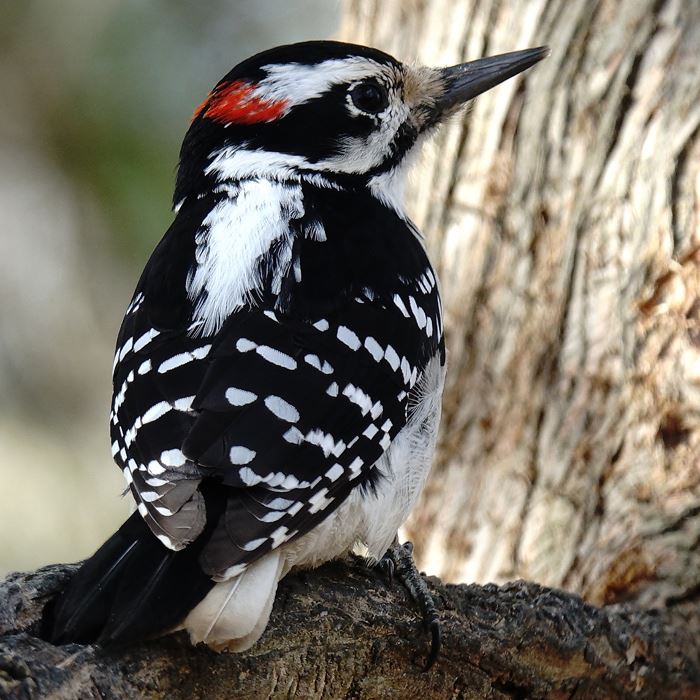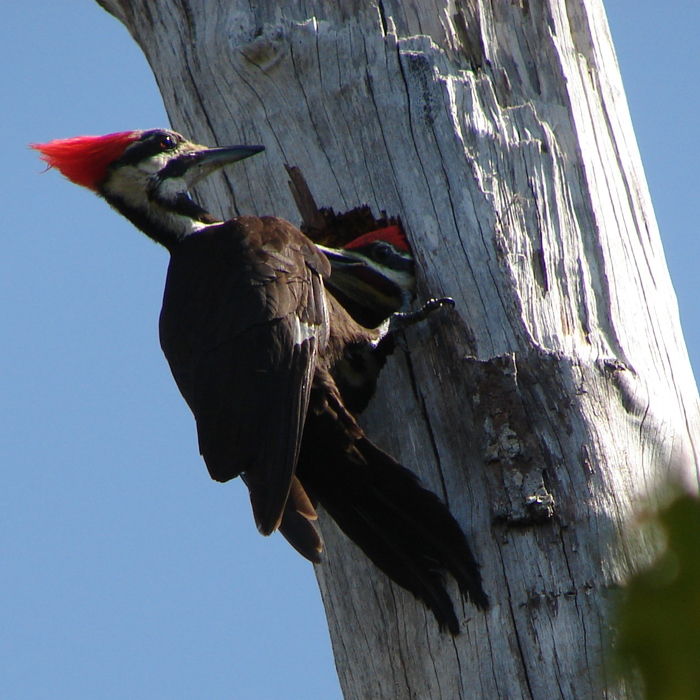Tapping to the Beat of their Own Drum

By Karen Menard
Drum roll…….please!
Like serious, woodland percussionists, woodpeckers are busy this time of year broadcasting their own drum solos, expertly tapping tempos their way on the best sound amplifiers found in nature—hollow trees and logs.
Any skilled timpanist knows that both the correct instrument and technique provides the vital heartbeat of any ensemble. In the case of our resident woodpeckers, locating available wood with the best resonance may make or break their success in being able to musically drum out territory boundaries and in choosing a mate. Hollowed out trees and snags in a forest community are very important assets.
As songbirds use their melodies to mark breeding territories and attract mates, woodpeckers having the same goals, communicate through a rapid concerto of reverberating drumbeats blasted far across the landscape. The bolder and healthier the sound, the more attractive they are to a potential mate; and both males and females actually take part in this effort. Characteristic bird songs and calls are much easier to identify than these woodpecker beats, as the tricky, rhythmic repetition and audibility does vary between species.
The Drummer of the Year award could easily go to the Hairy woodpecker in recognition of its ability to knock out an impressive amount of taps in so little time. At full speed, its chiseled bill can strike the side of a tree at a whopping 26 beats per second! In comparison, rock-shattering jackhammers operate between 25 and 50 beats per second. Surprisingly, even some of these lesser powered devices are still in the same range as the Hairy.
If you’ve ever watched a jackhammer at work, its ability to tear apart anything requires brute force. The same holds true for woodpeckers, but with a catch. Whether they are drumming, excavating, or foraging, these birds are always well equipped with special physical adaptations that offer protection from injury.
Features like thick, chiseled bills allow birds to slice into the wood itself, redirecting energy and further dissipating shock. Flexible cartilage located between the bill and skull also offers an extra layer of cushioning. A thick skull and spongy bone layer protects the brain, serving as a type of built-in helmet. Additionally, strong neck and head muscles aid in the distribution and absorption of continued impact, further ensuring no concussions or headaches.

As you walk along a woodland trail this spring, take a moment and listen for the drummed sequence of messages that many species of woodpeckers may be sending to each other. Try to see if you can identify differences in the types of drummed tempos (speeds) and patterns that you hear. You may be surprised at the amount of species drumming in the same area, as northwest Ohio has up to 7 kinds of woodpeckers that may be heard during the spring season.
Did you know?
The Guinness record for the world’s fastest drummer is held by an 11-year old from Australia. He achieved this honor with drumbeats of 39.5 per second!
Sometimes, woodpeckers even resort to drumming on the sides of houses, metal downspouts, trash cans or other objects that may amplify sound easily.
-
Photos: (Top) Hairy woodpecker, stock photo. Pileated nesting cavity, by Karen Menard